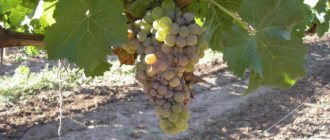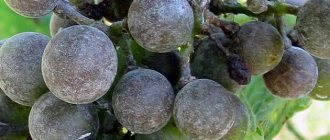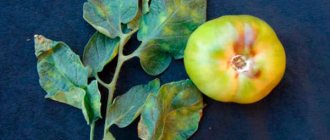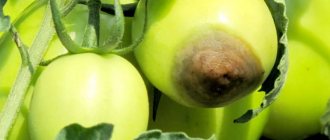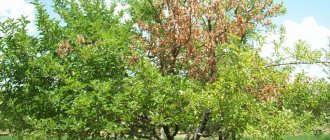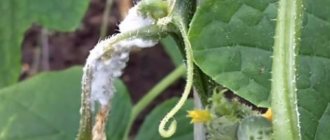Moniliosis or fruit rot is a dangerous disease that affects some types of fruit trees. It is caused by a special type of fungus. Most often, apple and pear trees suffer from moniliosis. The disease is widespread in all areas where these fruit crops are grown. Fruit rot is characterized by the appearance of brown spots on the fruit, which then turn into concentric circles of light-colored tubercles. Most often, fruits are affected during the ripening phase. Fruit rot also spreads to fruits removed from the tree and can destroy all apples during transportation.
Stages
Moniliosis is caused by the ascomycete fungus Monilinia fructigena Honey. This organism lacks chlorophyll, so photosynthesis does not occur in it, and the organic tissues of the affected plant serve as food for the fungus. During development, the disease can go through two stages: conidial and sclerotial.
Conidial
This stage forms a mycelium with a large number of single-celled conidia, which form elongated chains. Conidia are asexual spores. With their help, the causative agent of moniliosis multiplies. Spores are spread and transported by wind, rain and insects. Once in a favorable environment, the spores move to the next generation and begin to actively divide, affecting an increasingly larger area of the fruit plant. Fruits of apple and pear trees that have mechanical damage from natural factors or insects, as well as fruits affected by scab, are very quickly affected. This disease develops most actively in humid and warm weather.
Figure: Conidial stage of apple disease.
Sclerotial
This stage is otherwise called the resting stage. Since the life cycle of the fungus coincides with the fruiting period, in the cold winter time the life processes in the spores stop. At this time, the fungus overwinters in the bark of a tree or fruits, which become mummified. Such a fruit or sclerotia is a wrinkled formation with a black shiny skin. Inside the sclerotia there are large numbers of fungal spores that are in an inactive or dormant state. In the southern regions of the country, the development of spores does not stop in winter, which is the main factor in the recurrence of the disease in the spring. There is also a marsupial form of the disease, which is quite rare in the European part of Russia. Its distribution area is the regions of the Far East.
Infected and mummified fruits that remain on the soil under trees are sources of primary fruit rot infection. Therefore, all diseased carrion should be destroyed and the soil disinfected.
Development of the disease in autumn
Often, throughout the summer months, the mycelium of the fungus does not manifest itself in any way, but becomes active only at the beginning of autumn. This fact causes rotting of an already ripe crop. The leaves acquire a brown tint, and the fruits rot en masse in a short time, some of them dry out and remain on the trees. Lack of timely treatment will lead to the expansion of fungal colonies, which will subsequently cause irreparable damage to the garden. The condition of the apple trees will deteriorate every year and eventually they will die.
The first wormy drop of early apple varieties indicates the presence of moniliosis.
Since the thick skin of apples will make it difficult for fungal spores to penetrate inside, late winter varieties with characteristic thick skin are less susceptible to fruit rot.
Rotting of ripened fruits: methods of eliminating the problem
A fungal infection penetrates into the fruit through areas damaged in one way or another. After identifying the first signs of moniliosis, gardeners immediately resort to measures aimed at solving the problem. When treating apple trees with almost ripe fruits, bacterial preparations and folk remedies are used that do not cause harm to health. In addition, during the fruiting period a number of preventive procedures are performed, such as:
- timely elimination of weeds growing near trees;
- periodic collection and destruction of carrion;
- removal of damaged fruits from apple trees and subsequent disposal;
- pruning and removal of dried bark, branches, leaves;
- providing chemical protection (1 month before harvesting);
- treating the trunk circles of infected trees with copper sulfate (60 g / 10 l of water) or the preparation “Hom” (80 g / 10 l);
- applying fertilizers before winter and digging the soil.
During the harvesting process, not a single fruit should be left on the tree, otherwise in the spring they will become sources of infection.
All apples affected by moniliosis, as well as trimmed bark and branches, are burned. As an option, it is permissible to bury them in a hole at a depth of at least 50 cm. All manipulations are carried out outside the garden. You should not use such garbage to make compost, as such a solution will contribute to the further spread of fruit rot.
Moniliosis is a fungal disease common in the northwestern and central regions of the Russian Federation. Its treatment is a rather difficult process that continues throughout the entire growing season. It is possible to obtain the desired result only with proper implementation of all treatment procedures and regular preventive measures.
Previous
Diseases

